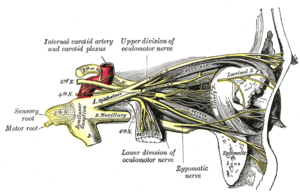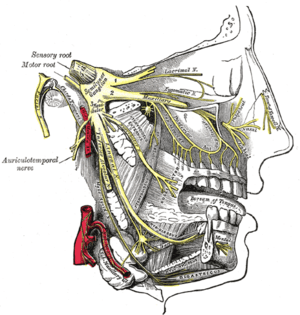Zygomatic nerve
The zygomatic nerve is a branch of the maxillary nerve, itself a branch of the trigeminal nerve (CN V). It travels through the orbit and divides into branches that provide sensory innervation to skin over the zygomatic and temporal bones.[1]
| Zygomatic nerve | |
|---|---|
 Lateral view of the nerves of the orbit. The zygomatic nerve is visible at bottom centre branching from the maxillary nerve. | |
| Details | |
| From | maxillary nerve |
| To | zygomaticotemporal nerve communicating branch to lacrimal nerve |
| Identifiers | |
| Latin | nervus zygomaticus |
| TA | A14.2.01.056 |
| FMA | 52967 |
| Anatomical terms of neuroanatomy | |
Structure
The zygomatic nerve branches from the maxillary nerve at the pterygopalatine ganglion. It travels from the pterygopalatine fossa through the inferior orbital fissure to enter the orbit. In the orbit it travels anteriorly along the lateral wall. Soon after it enters the orbit it divides into the zygomaticotemporal and zygomaticofacial nerves. These nerves then travel through identically named foramina in the orbital surface of the zygomatic bone.
Branches
- communicating branch to lacrimal nerve
- zygomaticotemporal nerve
- zygomaticofacial nerve
Function
The terminal branches of the zygomatic nerve contain sensory axons which provide innervation to the skin overlying the temporal and zygomatic bones.
The zygomatic nerve also carries postganglionic parasympathetic axons. These axons have their cell bodies in the pterygopalatine ganglion. They travel from the ganglion to the zygomatic nerve and then to the lacrimal nerve through a communicating branch. From the lacrimal nerve they enter the lacrimal gland and provide secretomotor innervation.
Variation
Sometimes the zygomatic nerve doesn't branch within the orbit and rather enters a single foramen in the zygomatic bone called the zygomatico-orbital foramen. In this case, it divides within the bone into the zygomaticotemporal and zygomaticofacial nerves.[1]
Additional images
 The nerves of the scalp, face, and side of neck.
The nerves of the scalp, face, and side of neck. Branches of the trigeminal nerve. The zygomatic nerve is visible branching from the maxillary nerve and entering the orbit.
Branches of the trigeminal nerve. The zygomatic nerve is visible branching from the maxillary nerve and entering the orbit.
References
- Standring, Susan, ed. (2016). Gray's anatomy : the anatomical basis of clinical practice (41 ed.). Philadelphia: Elsevier. ISBN 978-0-7020-5230-9. OCLC 920806541.